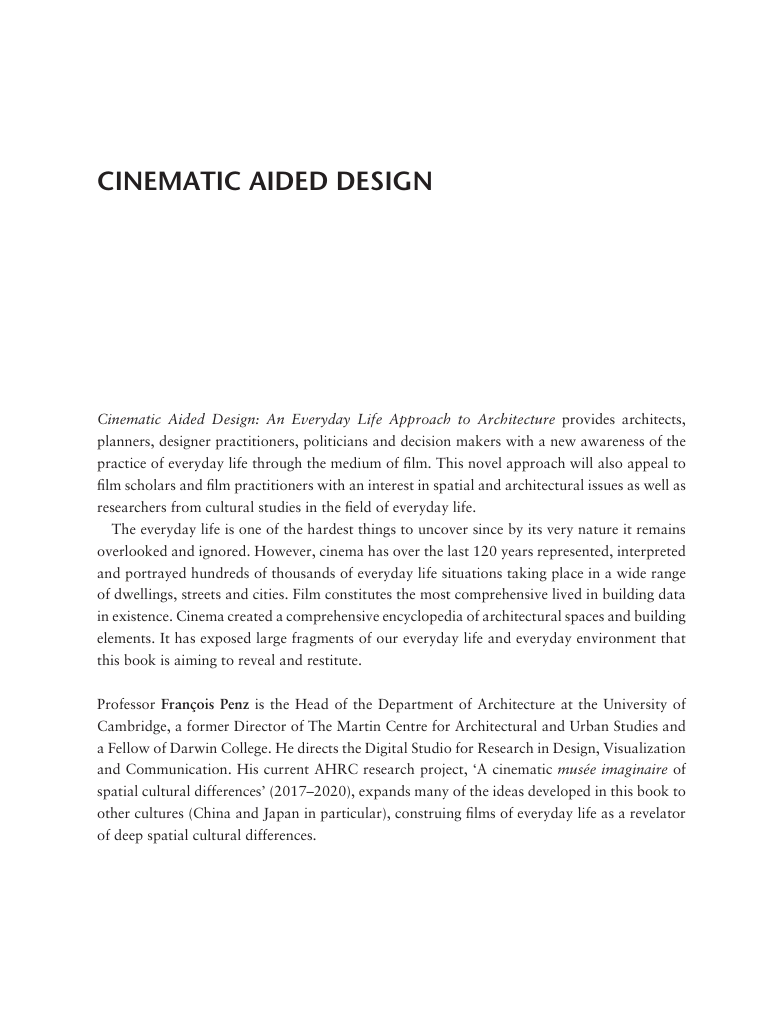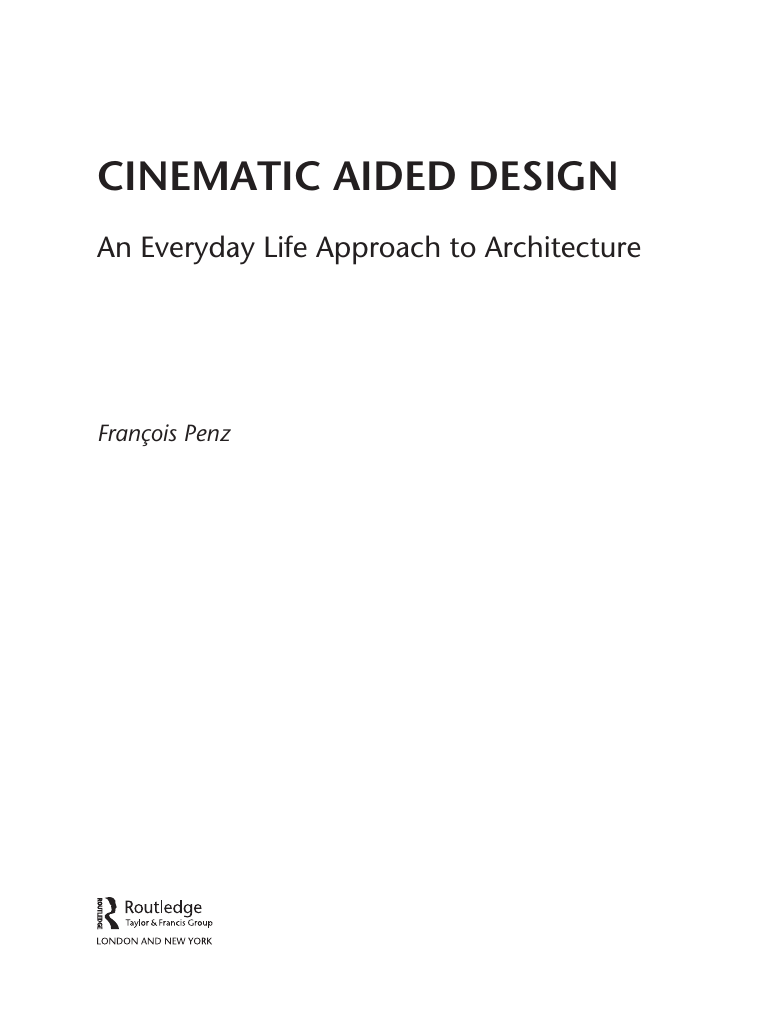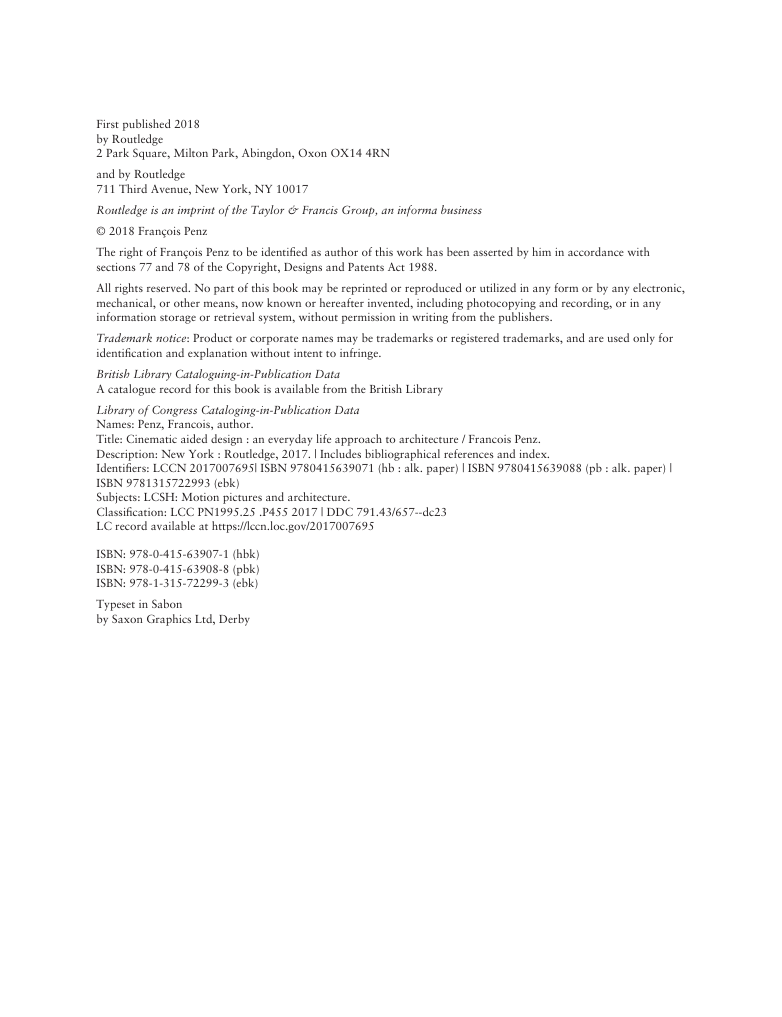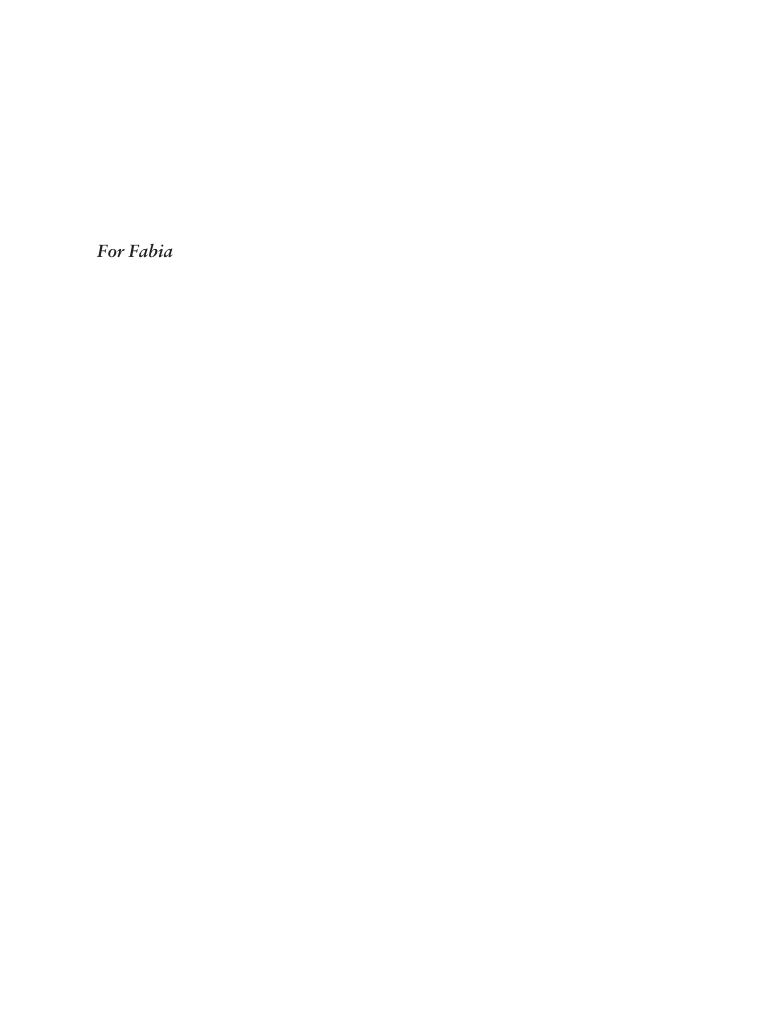�
‘In Cinematic Aided Design François Penz has invented a kind of meta architecture, an
imaginary Cinecitta where the production of architecture and film reflect and refract each
other’s gaze on the everyday. Penz casts Henri Lefebvre and Georges Perec to lead a purposely
in-disciplined ensemble cast of film makers and architects to find our truths in the everyday
space of our lives.’
– Tom Emerson, director, 6a architects, London & professor at the
Department of Architecture, ETH Zürich, Switzerland
‘In Cinematic Aided Design, François Penz argues persuasively that narrative cinema offers a
vast library of demonstrations of architecture in use. Exploring the everyday spaces of fiction
films, he identifies the essential value of moving images for architects and architecture.’
– Patrick Keiller
‘Francois Penz is interested in what happens to architecture once it is handed over to a client,
and he sees film as an accidental archive that makes visible how we live, love, work and sleep
in buildings. His fascinating book offers some sparkling insights into how architects can enrich
the design process with mundane knowledge. More than that, it is the best account I have read
of how cinema can help us to understand the everyday.’
– Joe Moran, Professor of English and Cultural History,
Liverpool John Moores University, UK
�
CINEMATIC AIDED DESIGN
Cinematic Aided Design: An Everyday Life Approach to Architecture provides architects,
planners, designer practitioners, politicians and decision makers with a new awareness of the
practice of everyday life through the medium of film. This novel approach will also appeal to
film scholars and film practitioners with an interest in spatial and architectural issues as well as
researchers from cultural studies in the field of everyday life.
The everyday life is one of the hardest things to uncover since by its very nature it remains
overlooked and ignored. However, cinema has over the last 120 years represented, interpreted
and portrayed hundreds of thousands of everyday life situations taking place in a wide range
of dwellings, streets and cities. Film constitutes the most comprehensive lived in building data
in existence. Cinema created a comprehensive encyclopedia of architectural spaces and building
elements. It has exposed large fragments of our everyday life and everyday environment that
this book is aiming to reveal and restitute.
Professor François Penz is the Head of the Department of Architecture at the University of
Cambridge, a former Director of The Martin Centre for Architectural and Urban Studies and
a Fellow of Darwin College. He directs the Digital Studio for Research in Design, Visualization
and Communication. His current AHRC research project, ‘A cinematic musée imaginaire of
spatial cultural differences’ (2017–2020), expands many of the ideas developed in this book to
other cultures (China and Japan in particular), construing films of everyday life as a revelator
of deep spatial cultural differences.
�
�
CINEMATIC AIDED DESIGN
An Everyday Life Approach to Architecture
François Penz
�
First published 2018
by Routledge
2 Park Square, Milton Park, Abingdon, Oxon OX14 4RN
and by Routledge
711 Third Avenue, New York, NY 10017
Routledge is an imprint of the Taylor & Francis Group, an informa business
© 2018 François Penz
The right of François Penz to be identified as author of this work has been asserted by him in accordance with
sections 77 and 78 of the Copyright, Designs and Patents Act 1988.
All rights reserved. No part of this book may be reprinted or reproduced or utilized in any form or by any electronic,
mechanical, or other means, now known or hereafter invented, including photocopying and recording, or in any
information storage or retrieval system, without permission in writing from the publishers.
Trademark notice: Product or corporate names may be trademarks or registered trademarks, and are used only for
identification and explanation without intent to infringe.
British Library Cataloguing-in-Publication Data
A catalogue record for this book is available from the British Library
Library of Congress Cataloging-in-Publication Data
Names: Penz, Francois, author.
Title: Cinematic aided design : an everyday life approach to architecture / Francois Penz.
Description: New York : Routledge, 2017. | Includes bibliographical references and index.
Identifiers: LCCN 2017007695| ISBN 9780415639071 (hb : alk. paper) | ISBN 9780415639088 (pb : alk. paper) |
ISBN 9781315722993 (ebk)
Subjects: LCSH: Motion pictures and architecture.
Classification: LCC PN1995.25 .P455 2017 | DDC 791.43/657--dc23
LC record available at https://lccn.loc.gov/2017007695
ISBN: 978-0-415-63907-1 (hbk)
ISBN: 978-0-415-63908-8 (pbk)
ISBN: 978-1-315-72299-3 (ebk)
Typeset in Sabon
by Saxon Graphics Ltd, Derby
�
For Fabia
�
















 2023年江西萍乡中考道德与法治真题及答案.doc
2023年江西萍乡中考道德与法治真题及答案.doc 2012年重庆南川中考生物真题及答案.doc
2012年重庆南川中考生物真题及答案.doc 2013年江西师范大学地理学综合及文艺理论基础考研真题.doc
2013年江西师范大学地理学综合及文艺理论基础考研真题.doc 2020年四川甘孜小升初语文真题及答案I卷.doc
2020年四川甘孜小升初语文真题及答案I卷.doc 2020年注册岩土工程师专业基础考试真题及答案.doc
2020年注册岩土工程师专业基础考试真题及答案.doc 2023-2024学年福建省厦门市九年级上学期数学月考试题及答案.doc
2023-2024学年福建省厦门市九年级上学期数学月考试题及答案.doc 2021-2022学年辽宁省沈阳市大东区九年级上学期语文期末试题及答案.doc
2021-2022学年辽宁省沈阳市大东区九年级上学期语文期末试题及答案.doc 2022-2023学年北京东城区初三第一学期物理期末试卷及答案.doc
2022-2023学年北京东城区初三第一学期物理期末试卷及答案.doc 2018上半年江西教师资格初中地理学科知识与教学能力真题及答案.doc
2018上半年江西教师资格初中地理学科知识与教学能力真题及答案.doc 2012年河北国家公务员申论考试真题及答案-省级.doc
2012年河北国家公务员申论考试真题及答案-省级.doc 2020-2021学年江苏省扬州市江都区邵樊片九年级上学期数学第一次质量检测试题及答案.doc
2020-2021学年江苏省扬州市江都区邵樊片九年级上学期数学第一次质量检测试题及答案.doc 2022下半年黑龙江教师资格证中学综合素质真题及答案.doc
2022下半年黑龙江教师资格证中学综合素质真题及答案.doc